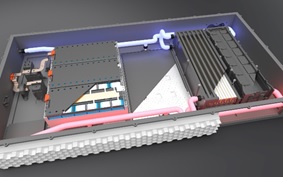Automotive Tier 1 Novares and DuPont™ Mobility & Materials are co-developing a new hybrid plastic/metal cooling plate that will help OEMs extend the range and lifetime of their EV batteries. One key to this new project is the patented plastic/metal bonding technology developed at DuPont’s technology center in Meyrin, Switzerland.
Novares is a global designer and manufacturer of complex components and systems for its OEM customers. “In collaboration with application development engineer Vincent Descombes, and the experts from DuPont’s Centers of Excellence for automotive electrification and assembly techniques, the engineers at our Powertrain China Skill Center were able to overcome technical challenges and provide a disruptive solution for EV battery cooling,” said Laurent Vanholme, Expert Powertrain Components at Novares. “We were able to master the difference in thermal expansion between the metal and plastic parts, and re-engineer the product to be processed with conventional welding.”

Developed at the company’s Automotive Electrification Center of Excellence, the plastic/metal bonding technology patented by DuPont enables the efficient manufacturing of a wide range of components for automotive and other industries. The technology was initially developed to support companies intent on replacing metal EV battery cooling plates with hybrid designs that are more economical to produce and that also better manage EV battery temperature. Novares confirmed that its cooling plates meet industry requirements and enable cost reduction versus all-metal alternatives.
Key to the success of these hybrid cooling plates is DuPont™ Zytel® HTN high-temperature nylon, which withstands the temperatures and aggressive chemicals in these applications and has excellent flow properties that enable complex designs.
Also key is DuPont’s patented bonding technology. This technology – which can be integrated into the injection moulding process – enables quick hot plate welding of aluminium to injection-moulded parts made of Zytel® or Zytel® HTN. Although the metal and the thermoplastics have different coefficients of thermal expansion, the bond between these disparate materials is strong enough to withstand extreme temperatures and aggressive chemicals.














